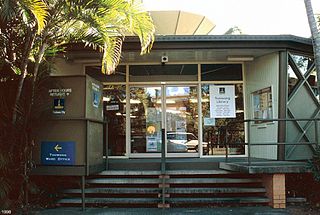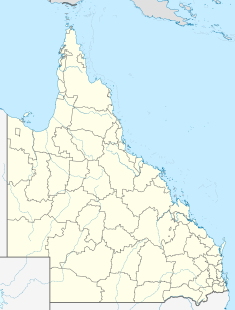
The Brisbane Showgrounds is a multi-purpose venue located in Bowen Hills, Brisbane. Established in 1875, it hosts more than 250 events each year, the largest being the Royal Queensland Show (Ekka).

Customs House is a heritage-listed customs house at 427 Queen Street, Brisbane CBD, Brisbane, Queensland, Australia. It was designed by Charles H McLay and built from 1886 to 1889 at a cost of £38,346 by John Petrie & Son. It was originally used for the collection of customs duty and was opened in 1889, when Queensland was a British colony, replacing the original Customs House located at Petrie Bight. It was added to the Queensland Heritage Register on 7 February 2005.

Regatta Hotel is a heritage-listed hotel at 543 Coronation Drive on the corner of Sylvan Road, Toowong, City of Brisbane, Queensland, Australia. It faces the Toowong Reach of the Brisbane River and was named after the rowing regattas held there. It was designed by Richard Gailey and built in 1886 by George Gazzard. It was added to the Queensland Heritage Register on 21 October 1992.

The Spring Hill Reservoirs are two heritage-listed former underground water storage reservoirs within Wickham Park at 230 Wickham Terrace, Spring Hill, City of Brisbane, Queensland, Australia. They are also known as Service Reservoirs. They were added to the Queensland Heritage Register on 21 October 1992.

The Ithaca Town Council Chambers is a heritage-listed former town hall of the former local government area of the Town of Ithaca, and now a community centre in Paddington, City of Brisbane, Queensland, Australia. Located at 99 Enoggera Terrace, Red Hill, it was designed by Atkinson and McLay and built in 1910 by Charles Thomas Hall and Francis Joseph Mayer. It is also known as Ithaca Library and Red Hill Kindergarten. It was added to the Queensland Heritage Register on 24 March 2000.

St Agnes Anglican Church is a heritage-listed churchyard at Ipswich Street, Esk, Somerset Region, Queensland, Australia. It was designed by John Hingeston Buckeridge and built in 1889 by Lars Andersen. It is also known as St Agnes Rectory and Church Hall. It was added to the Queensland Heritage Register on 21 October 1992.

St James Parish Hall is a heritage-listed church hall at 112 Russell Street, Toowoomba, Queensland, Australia. It was designed by Henry James (Harry) Marks and built in 1912. It is also known as Taylor Memorial Institute. It was added to the Queensland Heritage Register on 28 March 1995.

Baptist City Tabernacle is a heritage-listed Baptist church at 163 Wickham Terrace, Spring Hill, Brisbane, Queensland, Australia. It was designed by Richard Gailey and built from c. 1889 to 1890. It was added to the Queensland Heritage Register on 21 October 1992. The church is affiliated with the Australian Baptist Ministries.

Chateau Nous is a heritage-listed villa at 1 Rupert Terrace, Ascot, Queensland, Australia. It was designed by Douglas Francis and Woodcraft Roberts. It was built from c. 1937 to 1940s. It was added to the Queensland Heritage Register on 21 October 1992.

Brisbane School of Arts is a heritage-listed school of arts at 166 Ann Street, Brisbane City, City of Brisbane, Queensland, Australia. It was built from 1865 to 1985. It is also known as former Servants Home. It was added to the Queensland Heritage Register on 21 October 1992.

The Toowong Municipal Library Building is heritage-listed former public library at 579–583 Coronation Drive, Toowong, City of Brisbane, Queensland, Australia. It was designed by James Birrell and built in 1961 by Stuart Brothers. It was added to the Queensland Heritage Register on 28 August 1998. In 2001, the library moved to Toowong Village Shopping Centre and the original building has been used as business premises.

Boondah is a heritage-listed detached house at 50 Howard Street, Paddington, City of Brisbane, Queensland, Australia. It was apparently designed by Richard Gailey and built c. 1907. It was added to the Queensland Heritage Register on 11 June 1993.

St Patrick's Church is a heritage-listed Roman Catholic church at 58 Morgan Street, Fortitude Valley, City of Brisbane, Queensland, Australia. It was designed by Andrea Giovanni Stombuco and built from 1880 to 1882 by John Arthur Manis O'Keefe. It was added to the Queensland Heritage Register on 21 October 1992.

Mountview House is a heritage-listed detached house at 37 Leichhardt Street, Spring Hill, City of Brisbane, Queensland, Australia. It was originally built in the 1860s with a new wing added in 1882 designed by Andrea Stombuco. It was added to the Queensland Heritage Register on 13 May 2004.

Moody's Cottages are a heritage-listed pair of houses, one a duplex and the other a detached house, at 8–12, & 16 Victoria Street, Spring Hill, City of Brisbane, Queensland, Australia. It was built c. 1875. It is also known as Allandoon and Cooee. It was added to the Queensland Heritage Register on 21 October 1992.

Fortitude Valley State School is a heritage-listed former state school at 95 Brookes Street, Fortitude Valley, City of Brisbane, Queensland, Australia. It was designed by Benjamin Backhouse and built from 1867 to 1913. It is also known as State Emergency Services State Headquarters and former Fortitude Valley Boys School and former Fortitude Valley Girls and Infants School. It was added to the Queensland Heritage Register on 26 March 1999.

Dalby Olympic Swimming Pool is a heritage-listed swimming pool at 58 Patrick Street, Dalby, Western Downs Region, Queensland, Australia. It was designed by Clifford Ernest Plant and built in 1936. It was added to the Queensland Heritage Register on 20 March 2008.

Brisbane Grammar School Buildings are a heritage-listed group of private school buildings of Brisbane Grammar School, 24 Gregory Terrace, Spring Hill, City of Brisbane, Queensland, Australia. They were added to the Queensland Heritage Register on 21 August 1992.

Cannon Hill State School is a heritage-listed state school at 845 Wynnum Road, Cannon Hill, City of Brisbane, Queensland, Australia. It was added to the Queensland Heritage Register on 12 June 2015.
Buranda State School is a heritage-listed state school at 24 Cowley Street, Woolloongabba, City of Brisbane, Queensland, Australia. It was designed by Department of Public Works (Queensland) and built from 1920 to 1928. It was added to the Queensland Heritage Register on 28 April 2017.























